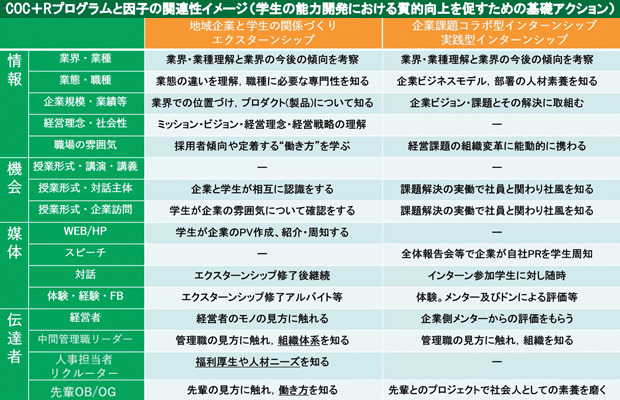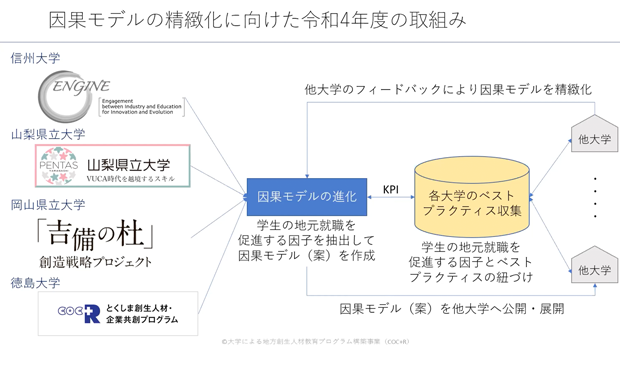The second day of the national symposium of the "University-based Regional Revitalization Human Resources Education Program (COC + R)" held on February 2022, 2, and the 13rd year of Reiwa, was "" Regional Revitalization Human Resources Development ". It was held in a workshop format with the theme of "What is the causal relationship between the program" and "local employment of human resources that local universities should produce".We aim to build a causal model that will be linked to the major theme of the symposium, "Human Resources Production." Looking back on the four COC + R businesses, what kind of "factors" should be identified?Presentations and discussions were held from each business responsible university.
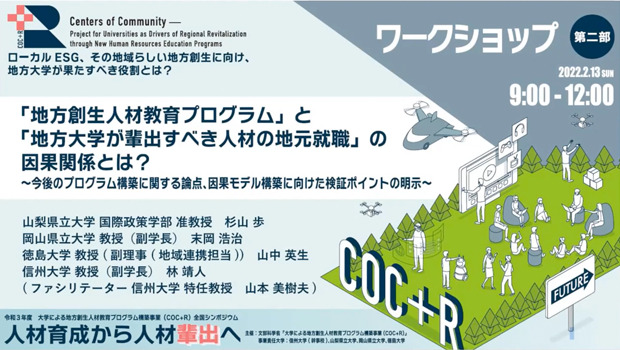
First, organize by three stakeholders, "company," "university," and "student."
First, the facilitator, Professor Shunsuke Yano of Shinshu University, summarized the first day of the symposium held the day before.From the keynote speech to the four workshops, all the content is deeply and deeply related to COC + R, and this alone is worth listening to.
Next, facilitator Mikio Yamamoto, a specially appointed professor at Shinshu University, gave an overview of Part XNUMX.With the content of the first day as the "foundation" for local employment, it is an attempt to complete an educational program that promotes local employment by building a "causal model".In order to realize exit-integrated education that promotes local employment of students, we will extract "factors" from each university, student, and company, and discuss how to make them work and link them to human resource development. If you formulate the formula "y = aX + b" and use y as a local employment, the overall structure is to find out the factors that work effectively.
After each instructor explained the contents of the four COC + R projects, he reported what factors could be discovered.
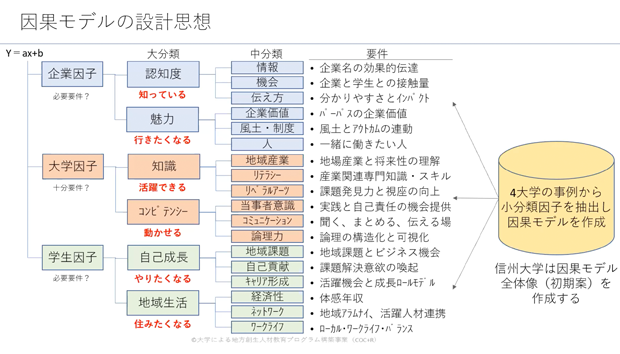
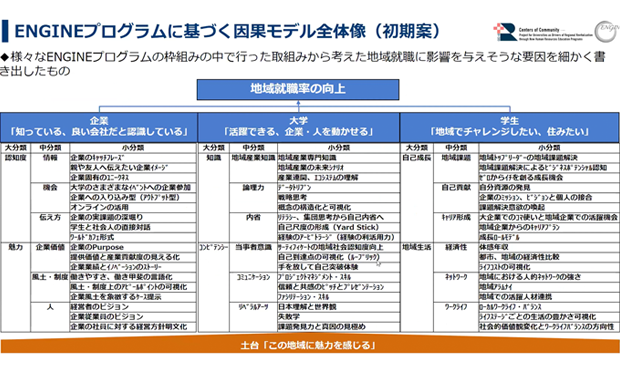
What factors are hidden in community orientation ── Shinshu University
"Human Resources Creation Program" ENGINE "to redefine and redefine regional core industries" in collaboration with Shinshu University, Toyama University, and Kanazawa University.In order to create a causal model, Assistant Professor Naoko Nishio of Shinshu University considered the factors that contribute to regional orientation.Shows a diagram of hypothesis design and explains the whole picture.She is said to have come up with ideas on what factors are influencing companies, universities, and students in order to improve local employment.She explained the factors that influence local employment by taking "Oshigo Talk" and "ENGINE Internship", which eliminate the distance between companies and students, and lesson subjects as examples.In order to clarify the factors, we segmented them into major classification → middle classification → minor classification, listed specific actions in the minor classification, and picked up those that seemed to be closely related as factors.
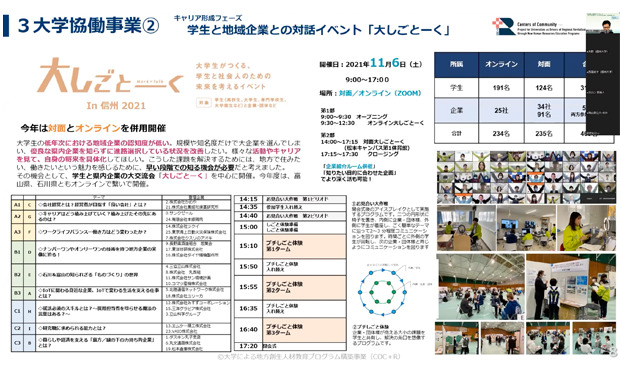
Mutual factors between students and companies are important ── Tokushima University
The University of Tokushima is implementing the "Tokushima Creation Human Resources Company Co-creation Program" in collaboration with local companies.It features a combination of on-campus externship (business visit training at a university) and hands-on internship (long-term training for 10 months to XNUMX months in a team).
Professor Hideo Yamanaka announced a deep dive into "corporate factors."Classify what is the key to raising awareness of a company and understanding its appeal, with feedback obtained from the program.We made a table that organized what kind of attractiveness of the local company was conveyed to the students, and many factors were discovered in the company information seen by the students in the externship, and the impressions and awareness from the company side.
By examining the effectiveness of the program, it is hypothesized that the interaction between corporate and student factors is important.He said that the efforts in this COC + R project may further change the mutual factors between companies and students.
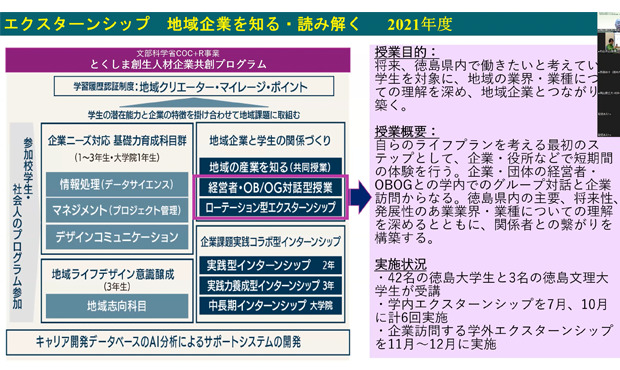
Senior liberal arts education and recurrent education are the keys ── Okayama Prefectural University
The COC + R project promoted by Okayama Prefectural University is a program titled "'Kibi no Mori'Creation Strategy Project-Aiming to Develop Weed-type Human Resources-".As "community contribution" is woven into the founding philosophy of the university, the "Okayama Creation Course" that incorporates the experience value accumulated by COC + is characteristic.Programs related to the three faculties of health and welfare, information engineering, and design have also been established, and the employment rate of students who have acquired "community revitalization promotion" is 3% higher than the average. am.
Professor Koji Sueoka, who digs deeper into the "university factor," said, "Through PBL exercises in graduate school subjects, it became clear that it is important to integrate senior liberal arts education with specialized education."Along with recurrent education, we want to cultivate human power by fusing it well, and fostering these will be a factor in the university program.
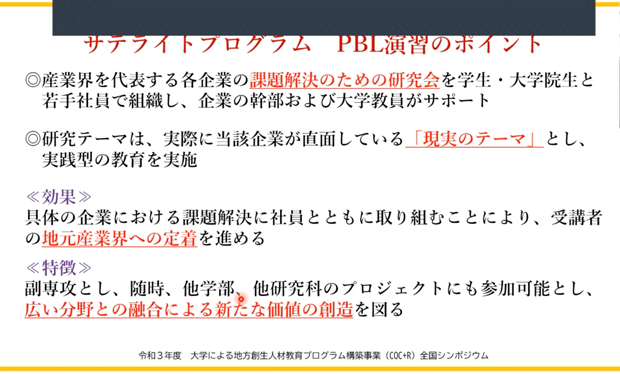
Adding new standards to promote local employment ── Yamanashi Prefectural University
Yamanashi Prefectural University is implementing a "practical education program that supports growth strategies in the VUCA era" as a COC + R project.We have a strategy to foster value-creating human resources and create a value-added industry in Yamanashi.The program, such as inviting people who are starting new things and expanding the number of students to working adults, was highly evaluated as being able to improve oneself.
In delving into the "student factor," Associate Professor Ayumu Sugiyama added new standards such as "strong against disasters and epidemics," "workplaces where university learning can be utilized," and "support environment after graduation" in order to raise the local employment rate. To do. "To do this, we need an environment where careers can be connected, learning can contribute to society, and you can recurrent yourself.She also emphasized the importance of learning opportunities with working people, educational programs that meet local needs, and teachers.
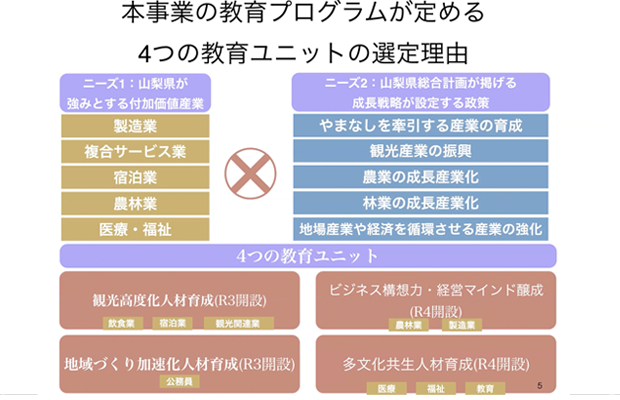
Quantify the causal model and expand it nationwide
Free discussion after the announcement of 4 universities. "Companies have come to the university in search of students who suit them (Professor Yamanaka)", "Setting up an environment where they can demonstrate their abilities most contributes to the local employment rate (Associate Professor Sugiyama)", etc. , Mr. Yamamoto and each of them exchanged opinions in the form of answering questions from the participants.
Next, Professor Yasuto Hayashi of Shinshu University said about COC + R in the 4th year of Reiwa, "We will determine the three factors listed above and quantify the contents of the variables. I would like to develop it as a causal model that can be utilized in. "
At the end, President Soichiro Nakamura of Shinshu University concluded the two-day symposium with the words, "I want to involve a diverse community through collaboration between industry, government and academia in the region. I hope we can provide feedback to the region as a base of knowledge."
